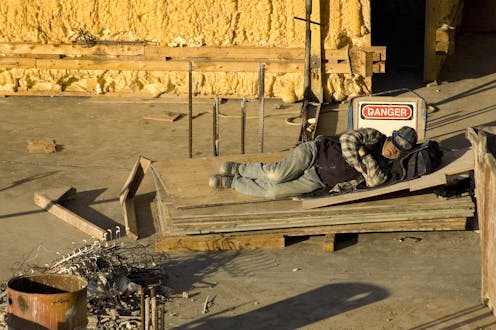Supporting worker sleep is good for business
- Written by Leslie Hammer, Professor, Oregon Health & Science University

A long-haul truck driver fell asleep[1] during his shift in Sunbury, Pennsylvania, on Jan. 13. Heading north on Route 147, he drifted into the eastbound shoulder for almost 375 feet, struck the side of the road and flipped his rig. Thankfully, the driver only suffered a minor injury and nobody else was harmed.
Poor sleep affects up to 70% of Americans[2] and increases the risk of shortened lifespan and death[3]. This includes deaths and injuries related to road accidents, stroke and reduced cardiovascular health.
Though sleep is not something you typically do at work, work schedules and job stress affect sleep, and poor sleep can affect job performance and safety at work. Police officers, firefighters, truck drivers and healthcare workers[4] are among those especially at risk for workplace fatigue.
We are health sciences[5] experts[6] and one of us – Leslie Hammer[7] – serves as co-director at the Oregon Healthy Workforce Center[8] which is supported by The National Institute for Occupational Safety and Health[9].
Recently, our team[10] has begun exploring the relationship between supervisor support and employee sleep[11].
The cost of workplace fatigue
Poor sleep has impacts on employee health and well-being that can negatively affect an employers’ bottom line[12].
In fact, sleep deprivation increases the chances of workplace injuries by 70%[13]. This is partially due to tired workers being less able to concentrate on workplace safety guidelines[14].
Sleep-related workplace safety issues, including accidents and injuries as well as long-term health consequences[15] of poor sleep, like heart disease, may require multiple days away from work, large insurance claims and increased draw on workers’ compensation benefits. That’s costly for both workers and employees.
Additionally, the U.S. incurs a productivity loss of more than $135 billion annually[16] as a result of inadequate sleep. Poor sleep causes symptoms similar to alcohol use[17], like impaired memory, motor skills and decision-making.
Employers can take easy, low cost steps to ensure their workers have the capability to sleep well and reduce chances of workplace injuries.
Our approach is focused on improving supervisor support of employees’ sleep. The majority of workplace trainings rely on employees to address their own sleep health. This is problematic, because many employees face challenges to improving their own sleep without outside support and education.
Studies support supervisor training
In February 2019, we published a study[18] looking at the impact of a supervisor support training intervention[19] on employee sleep. Fifty-six study groups, made up of 791 employees in a Fortune 500 information technology firm, participated in the study.
Half of the study groups attended in-person group meetings to identify new ways to increase control over their own work schedules. The supervisors and managers in those same groups received additional in-person family-supportive supervisor training to improve their support of employees’ family and non-work lives. Family-supportive supervisor[20] trainings teach supervisors and managers to promote work-family balance and provide emotional support and appropriate resources.
Workers reported their time asleep, how rested they felt upon waking, and any inability they had to fall asleep.They also wore sleep tracking[21] watches to measure their actual time spent sleeping each day.
Note that this study did not actually include a sleep training component. It was focused solely on providing employees more control over where and when they work and teaching their supervisors and managers to reduce demands, and better support employees’ work-family balance and perceived control.
We found that improving supervisors’ support of employees’ work-life balance[22] can benefit employees’ sleep in sustainable ways. In our study, both sleep quantity and quality increased up to 18 months after the training.
This study highlighted that an organization does not necessarily have to commit to a full sleep program – which might include sleep leadership training, establishment of nap rooms and employee training on sleep hygiene – to achieve improved employee sleep and positive work outcomes.
As long as organizations can commit to training supervisors to better support workers’ work, family, health and well-being, this can lead to reduced employee stress and correspondingly improved sleep and job performance.
References
- ^ fell asleep (www.dailyitem.com)
- ^ 70% of Americans (www.sleephealth.org)
- ^ increases the risk of shortened lifespan and death (academic.oup.com)
- ^ Police officers, firefighters, truck drivers and healthcare workers (www.sciencedirect.com)
- ^ health sciences (www.ohsu.edu)
- ^ experts (scholar.google.com)
- ^ Leslie Hammer (scholar.google.com)
- ^ Oregon Healthy Workforce Center (www.ohsu.edu)
- ^ The National Institute for Occupational Safety and Health (www.cdc.gov)
- ^ our team (www.ohsu.edu)
- ^ supervisor support and employee sleep (www.ncbi.nlm.nih.gov)
- ^ negatively affect an employers’ bottom line (www.ncbi.nlm.nih.gov)
- ^ chances of workplace injuries by 70% (sleepfoundation.org)
- ^ concentrate on workplace safety guidelines (www.ncbi.nlm.nih.gov)
- ^ long-term health consequences (academic.oup.com)
- ^ $135 billion annually (www.americansafetycouncil.com)
- ^ similar to alcohol use (www.medicaldaily.com)
- ^ published a study (www.ncbi.nlm.nih.gov)
- ^ supervisor support training intervention (workfamilyhealthnetwork.org)
- ^ Family-supportive supervisor (psycnet.apa.org)
- ^ sleep tracking (www.ncbi.nlm.nih.gov)
- ^ supervisors’ support of employees’ work-life balance (psycnet.apa.org)
Authors: Leslie Hammer, Professor, Oregon Health & Science University
Read more https://theconversation.com/supporting-worker-sleep-is-good-for-business-130101

